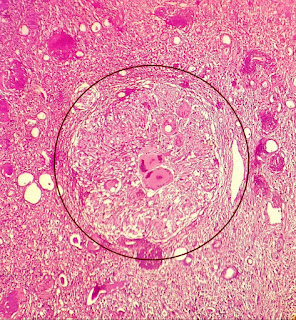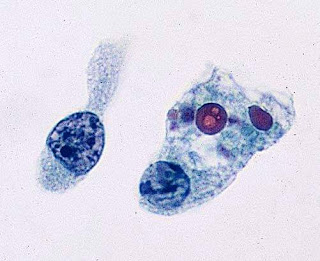Granuloma
Granuloma:
A granuloma is a structure formed during inflammation that is found in many diseases. It is a collection of immune cells known as macrophages. Granulomas form when the immune system attempts to wall off substances it perceives as foreign but is unable to eliminate. Such substances include infectious organisms including bacteria and fungi , as well as other materials such as keratin and suture fragments.
Histiocytes (specifically macrophages ) are the cells that define a granuloma. They often, but not invariably, fuse to form multinucleated giant cells ( Langhans giant cell ).The macrophages in granulomas are often referred to as "epithelioid ". This term refers to the vague resemblance of these macrophages to epithelial cells . Epithelioid macrophages differ from ordinary macrophages in that they have elongated nuclei that often resemble the sole of a slipper or shoe. They also have larger nuclei than ordinary macrophages and their cytoplasm is typically more pink when stained with eosin . These changes are thought to be a consequence of "activation" of the macrophage by the offending antigen.
Granulomas are seen in a wide variety of diseases, both infectious and non-infectious. Infections that are characterized by granulomas include tuberculosis , leprosy , histoplasmosis , cryptococcosis , coccidioidomycosis , blastomycosis and cat scratch disease . Examples of non-infectious granulomatous diseases are sarcoidosis , Crohn's disease, berylliosis , granulomatosis with polyangiitis, eosinophilic granulomatosis with polyangiitis, pulmonary rheumatoid nodules and aspiration of food and other particulate material into the lung.
Histiocytes (specifically macrophages ) are the cells that define a granuloma. They often, but not invariably, fuse to form multinucleated giant cells ( Langhans giant cell ).The macrophages in granulomas are often referred to as "epithelioid ". This term refers to the vague resemblance of these macrophages to epithelial cells . Epithelioid macrophages differ from ordinary macrophages in that they have elongated nuclei that often resemble the sole of a slipper or shoe. They also have larger nuclei than ordinary macrophages and their cytoplasm is typically more pink when stained with eosin . These changes are thought to be a consequence of "activation" of the macrophage by the offending antigen.
Granulomas are seen in a wide variety of diseases, both infectious and non-infectious. Infections that are characterized by granulomas include tuberculosis , leprosy , histoplasmosis , cryptococcosis , coccidioidomycosis , blastomycosis and cat scratch disease . Examples of non-infectious granulomatous diseases are sarcoidosis , Crohn's disease, berylliosis , granulomatosis with polyangiitis, eosinophilic granulomatosis with polyangiitis, pulmonary rheumatoid nodules and aspiration of food and other particulate material into the lung.
If you like, you can visit our youtube channel and facebook page👇🏻
Youtube channel link-https://m.youtube.com/channel/UCPGvHc5Ttw4EtB72WVMiYSw/videos
Facebook page link-https://m.facebook.com/PathologyDiscussionForum/?ref=bookmarks
Youtube channel link-https://m.youtube.com/channel/UCPGvHc5Ttw4EtB72WVMiYSw/videos
Facebook page link-https://m.facebook.com/PathologyDiscussionForum/?ref=bookmarks
Follow our facebook page for recent articles/videos 😎




Comments
Post a Comment
Thank you for posting your comment.Your question will be answered soon.